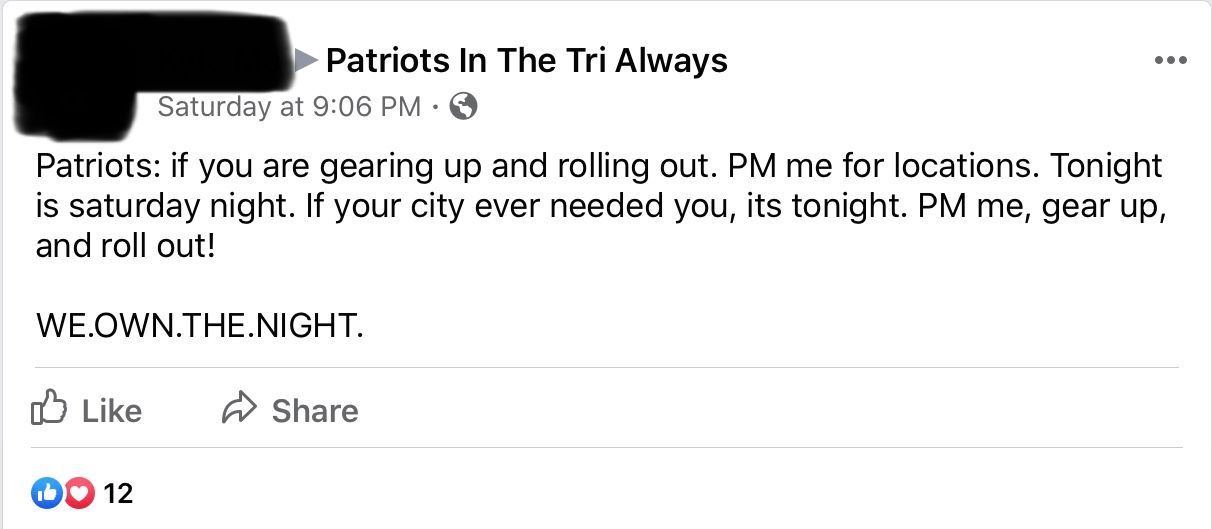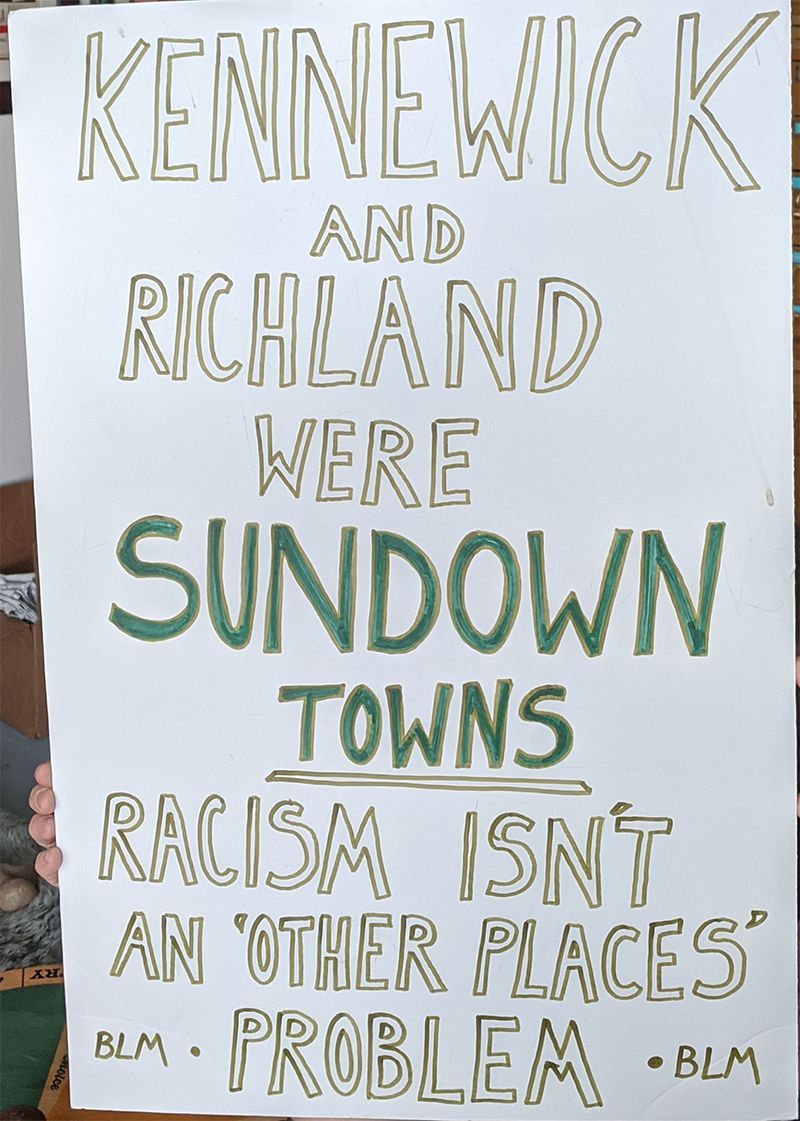UPDATE: A factual correction has been made to one of the details in this story. (See details at end of article.)
Historic Segregation Practices in the Tri-Cities
As someone whose family has lived in the Tri-Cities (specifically Kennewick) since 1990, this last week I have heard more reference to our area’s history of Jim Crow than in all of the preceding 30 years.
Being from here, I have often heard many white liberals laugh and say that we’re just not that diverse. But there are real historic reasons why people of color, and specifically Black Americans, have not found the Tri-Cities liveable and chose to move on, even if they did find employment here for some time.
The history of Jim Crow in the Tri-Cities is well laid out in an article by Robert Bauman, a professor at WSU Tri-Cities. He outlines how most of the labor for the early Hanford project in the 1940s and 50s was recruited from the South.
The white foremen they hired brought their segregationist practices with them. The Hanford project manager limited employment numbers to 20% African-American to appease white workers. So while Black folks came to Washington hoping that they would experience freedom from the South’s violent conditions, they were sadly disappointed. Former NAACP NW President Jack Tanner called Kennewick “the Birmingham of Washington.”
Black folks could only get menial jobs and would not be promoted to clerical work. Housing conditions were atrocious—renting trailers where whole families might fit into one room, and water taps that were few and far between and shared communally. Buses for workers were even segregated until Black workers organized to end that practice as discriminatory. Still, housing, restaurants, and other businesses were all segregated. People of color were only allowed to live in east Pasco.
Most famously, I remember my AP History teacher at Kamiakin tell us about a sign on a Kennewick-Pasco bridge that read, “N*****, you better not be caught out after dark.” He used the full word.
I remember being in shock, as one of the only brown kids in the room. It was the first and only time I heard mention about it until the last couple of weeks. I could not believe that people of color were not “allowed” in Kennewick after dark.
It’s called being a “sundown” town.
I brought this up earlier this week with Amber Rodriguez, a Black Latina community organizer in the Tri-Cities who has been a central voice for the local Black Lives Matter movement. She told me her father would tell stories about coming to the Tri-Cities from Yakima to visit friends, but he knew he had to be on the other side of the bridge before dark or “he would get handled.” I asked who would do the handling. Amber said, “The police when it was legal. After that, armed white men.”
There was a time very much in living memory when Black and Brown people were not “allowed” to be out after dark in Kennewick. Who didn’t allow it? White police. Later, when it became explicitly illegal, white armed militias.
Tanya Bowers, another local Black woman who is a Diversity, Equity, and Inclusion consultant says this in a letter to the editor in the Tri-City Herald published in September 2018, addressing the blindness our community has had to our racist past:
“There was also no mention [in a recent Herald article] of the green bridge’s racist symbolism. This Pasco-Kennewick bridge bore a sign stating that blacks had to be on the Pasco side by sunset. Kennewick was a sundown town, meaning that African Americans could not be within the city limits after dark. Pasco permitted blacks to live on the east of the train tracks. Restrictive covenants and, after those were declared illegal, voluntary practices between real estate agents and homeowners prevented African Americans from buying or renting property outside of east Pasco.”
As both Amber and Tanya emphasize, while discriminatory practices were legal, the police and the local government enforced policing and housing limitations on Black people living in the Tri-Cities. But once such laws were deemed illegal, the practices continued on, enforced by local white civilians.
The Resurgence of Armed White Militias
While the local Black community never stopped speaking about the Tri-Cities’ racist history, now it seems white residents are raising the issue en masse. There are armed, largely white groups who have ties to white supremacist tendencies and are currently patrolling Tri-Cities at night for the last week and a half.
This show of armed force is happening in the context of the Tri-Cities experiencing, along with much of small town America, the first significant wave of protests they have ever seen, in support of the Black Lives Matter movement. Protests have occurred multiple days a week, in all three cities. At least 2,000 people attended a recent protest in Kennewick. Many Tri-Citians are invigorated by this showing in support of inclusion and fair practices.
The armed groups have stated that they are patrolling businesses with the intent to prevent looters and rioters from damaging property. While looting and property damage have occurred in other cities in the context of the protests, the demonstrations here have been peaceful and the organizers are explicitly committed to nonviolence. A few windows were broken on the first weekend of protests by teenagers, but no property damage has been reported since then. The Kennewick Police Department acknowledged this past weekend that there are no looters or rioters either from in town or being bused in from other areas.
Local law enforcement was slow to respond to armed groups. Kennewick PD was shown as having taken photos with armed citizens in a local media outlet. After a young Black man was turned away from a parking lot by armed white civilians and released the video of it, KPD did reach out to educate armed groups, letting them know that when they are not in uniform, they are not allowed to police. Officers did validate their presence, saying that they could be valuable as “eyes” for the police, but they emphasized that even when off duty, they do not police. I have heard rumors that there is overlap between members of these militia groups and local law enforcement officers and I believe this statement was a specific reminder to those individuals.
Local People of Color Are Being Terrorized
Every Black and Brown person I’ve spoken to this week, including myself, feels afraid to be outside now. I have seen Black children cry for their safety. I have heard of grown Black men who are refusing to leave their houses.
The fear is palpable when you watch a video posted by Javan Williams of himself attempting to enter a parking lot and being turned away by armed white men. For those of us who know racial violence is all too real, and have experienced it in our bodies, we know this is how a wave of violence begins.
We are watching our backs extra during the days, too. We doubt the police’s ability and willingness to actually protect us from white supremacists who want to shoot us. Why would they, when the question posed by BLM is justice for George, Breonna, Ahmaud, and countless other Black people who have been murdered for being Black?
In a world that has been on fire since random white supremacists killed Ahmaud for taking a jog, it’s the ultimate form of bullshit to tell us that white militias arming themselves and patrolling have nothing to do with us. If you are more upset about broken windows than Black and Brown people being killed, then you are part of the problem.
People steal everyday from local businesses. It’s called shoplifting. No one arms themselves then. Kids in our town get bored and break windows and graffiti every weekend. No one arms themselves then. They are armed because Black people have the audacity to say that their lives matter.
Policing works like this on Black and Brown communities. Today’s militia mouthpieces might deny their own racism. They may say that their actions have nothing to do with Black Lives Matter, that they support protest. They are still stealing the conversation away from us. They are still responding to a nation and world alive with Black Lives Matter protests by showing their own lethal force.
BLACK LIVES MATTER. BLACK LIVES MATTER. BLACK LIVES MATTER.
This should be the explicit context of every conversation we have about what is happening in our country and community today. Whether it’s protests against police brutality and racial profiling of Black people. White militias arming themselves with semi-automatic assault rifles. Property owners valuing broken windows over the lives and freedom of Black and Brown people. Whether the cops are actually here for our protection or not. Who COVID-19 is going to kill.
Every conversation you have should be a heartbeat that sounds like BLACK LIVES MATTER. BLACK LIVES MATTER. BLACK LIVES MATTER. BLACK LIVES MATTER. BLACK LIVES MATTER.
Unfortunately, the conversation has been hijacked by people who know that explicit racism will get them canceled, but they continue to associate with known racists and white supremacists, and encourage behavior that smacks of our racist history. Dylan Tafoya, moderator of the Defend the Tri Facebook group, claims to support the protests. He was certainly present at one protest this past weekend, with other members of Defend the Tri. They have promised law enforcement to not attend with arms at our protests—but why are they there at all? This Huffington Post exposé of the Proud Boys organization demonstrates that groups like this have an explicit strategy to wait until protesters are provoked and then use force that they will justify as self-defense.
There are some who don’t believe that events from 70 years ago have any impact on our culture, behavior, or society today. That belief is borne out of white privilege. Many of our local leaders learned things from their parents and grandparents they still hold dear.
White Americans have a very short historic memory—Black and Brown Americans cannot afford that luxury. But most Americans do agree that Black folks are still suffering from the legacy of slavery. 70 years is not that long ago in our nation’s history.
BLACK LIVES MATTER. BLACK LIVES MATTER. BLACK LIVES MATTER. BLACK LIVES MATTER.
I have heard that the rallying cry of the militia groups is: "Let them have the day. We own the night."

The reality is, Kennewick and all of the Tri-Cities never stopped being a sundown town.
BLACK LIVES MATTER. BLACK LIVES MATTER. BLACK LIVES MATTER. BLACK LIVES MATTER.
CORRECTION: An earlier version of this post incorrectly stated that Kennewick Police Chief Hohenberg was seen in a video advising armed 'defenders'. It was in fact a group of officers led by Sargeant Chris Littrell. Afrose Ahmed reported the mistake to Tumbleweird editors and the piece was revised.
afrose fatima ahmed is a poet who also has a long history of antiracist community organizing. She is a Brown woman of South Asian descent. She is writing this article as both an ally to Black folks and as someone deeply invested in the elimination of white supremacy. Any shortcomings of this article belong to her, but she’s writing it because Black folks have enough to deal with at the moment to add educating white folks about their own racism to their plates.
More Resources:


